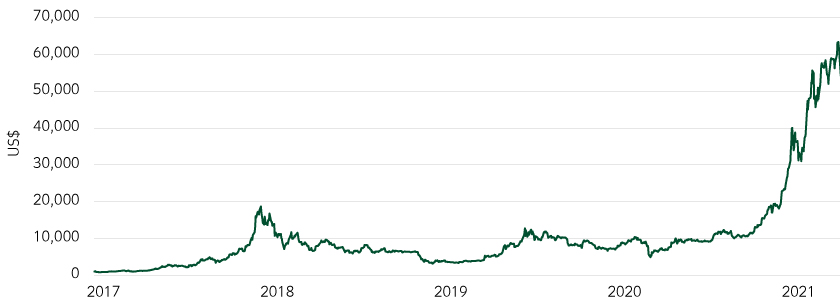A string of high-profile investments in Bitcoin, coupled with its meteoric price rise, has led many investors to consider how to access the growth in cryptocurrencies.
Bitcoin, the first and most widely used blockchain based-cryptocurrency, is a peer-to-peer digital cash system which relies on cryptographic proof rather than trust.
In our view, the high volatility, low liquidity, the possibility of market manipulation and operational challenges make Bitcoin unsuitable for most institutional investors, even in a currency portfolio. That said, we expect Blockchain, the technology that powers Bitcoin, to be adopted by governments to launch digital currencies, potentially impacting both monetary policy and credit creation.

While Bitcoin has gained popularity with retail investors, we believe it faces significant challenges as an asset and as a currency
- Volatility: The CME Group, the world's largest financial derivatives exchange, has quoted Bitcoin implied volatility at 106.6%, which is more than five times greater than the volatility of gold and almost four times the expected volatility of the S&P500, as quoted by the VIX.2
- Transaction time and cost: The average transaction time is around 10 minutes3, with a hard processing limit of just seven transactions per second. Transaction costs are high and have risen to as much as $55 per transaction4.
- Regulatory and ESG risk: Although not true of all cryptocurrencies, the regulatory and ESG-related risks of Bitcoin are significant. Bitcoin uses a large amounts of energy and is used extensively for illegal activities5. Market manipulation is also a significant risk for investors.
Central banks are carefully watching these developments
Central banks are learning from cryptocurrencies and considering their own digital and cryptocurrencies. These would allow them to gain greater transparency over transactions, potentially reducing tax avoidance and money laundering; and present potentially innovative ways to stimulate demand during periods of economic stress.
Central bank digital currencies are a potential solution for the 1.7 billion people who don’t have access to traditional banks, allowing for inclusive and efficient monetary policy and transmission.
While we do not expect Bitcoin, or any other private cryptocurrency, to replace traditional government backed currencies a combination of central bank digital currencies and other private cryptocurrencies are likely to take an increasing share of the global payments sphere.
Blockchain technology has significant applications outside of cryptocurrencies
Blockchain, a form of distributed ledger technology, has the potential to revolutionize how we validate and verify transactions. Distributed ledger technology is already being used to improve supply chain management, multi-party transaction processing and record keeping.
Investors can consider investing in a blockchain-based business to access potential growth. For investors seeking direct exposure, who can withstand the potentially high volatility, any exposure to cryptocurrencies should be managed by investors with a deep understanding of blockchain technology and related instruments.

Most read
Fixed income


August 2022
Is it time to consider high yield?
Liability-driven investment, Fixed income


July 2022
Liability Driven Insights: A pit stop on your de-risking journey
Global macro


April 2022
Global macro research: Modeling the persistence of US inflation
Global macro, Fixed income


May 2023
 United States
United States






















